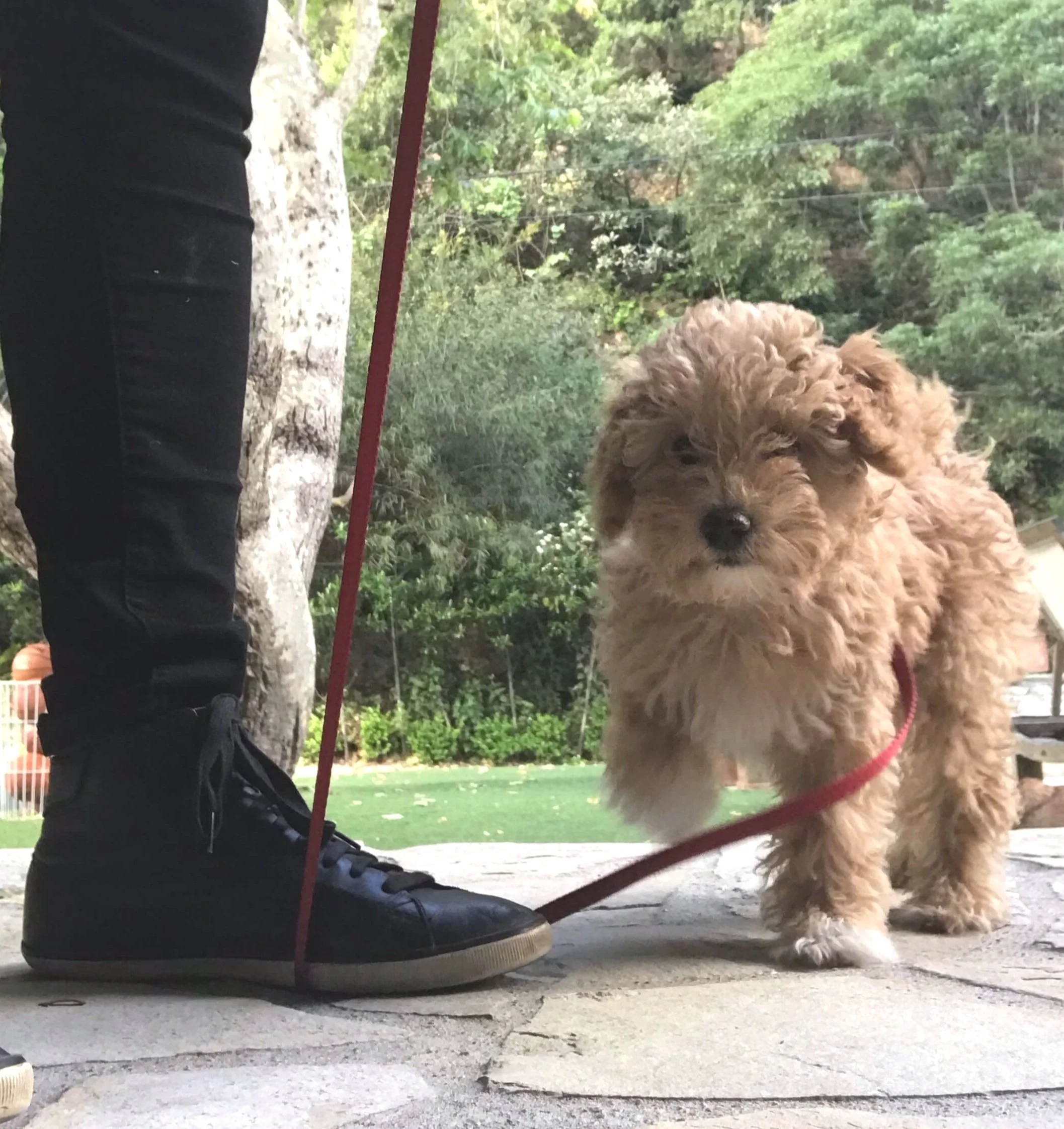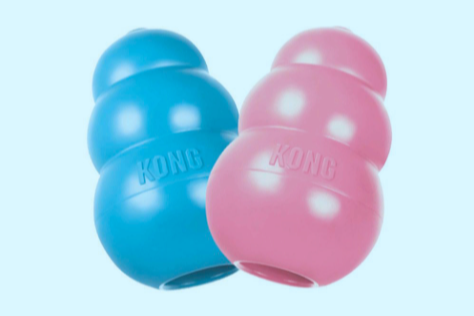How To Train a Dog or Puppy to Settle Down
Decompression Training: Teaching An Anxious Dog or Hyper Puppy to Settle Down
Decompression Training is a calming technique that uses gentle restraint or confinement to help dogs and puppies settle down in a variety of situations.
When used as part of a dog separation anxiety treatment plan, it helps anxious dogs begin to emotionally “cut the umbilical cord”—learning to feel safe and secure without needing to stay constantly near or within sight of their guardian.
For overstimulated dogs who become easily excited or reactive, decompression training teaches them how to settle before they reach a state of over-arousal.
By guiding the dog through the natural process of self-soothing, this method calms the limbic system—the reactive, emotional part of the brain—and activates the cerebral cortex, or thinking brain. In short, it helps dogs shift from a reactive state to a thoughtful one.
Once a dog reaches this calm state, we can begin counter-conditioning—a training technique that changes how a dog feels about confinement or being alone. Over time, feelings of anxiety, restlessness, overexcitement, or panic are gradually replaced by a growing ability to relax and feel secure.
While Decompression Training is especially helpful for dogs suffering from separation anxiety, it’s also a powerful calming tool in many other contexts, such as when introducing an anxious dog to new people and environments, training an anxious puppy settle down in a crate, or helping a hyper or overstimulated puppy settle down around distractions.
Applying the Principle of Negative Reinforcement: Teaching Dogs to Relax in Response to Stress
Los Angeles Dog Trainer, Alexandra Bassett, CPDT-KA, demonstrates Decompression training, a gentle and positive method of teaching a dog or puppy to calm down while confined in a crate or restrained on a tether.
Decompression Training combines desensitization and counter-conditioning with a key concept from learning theory—negative reinforcement—to gently teach puppies and dogs how to self-soothe and settle.
Negative reinforcement involves removing something unpleasant (in this case, it’s being restrained on a leash or released from confinement) to increase the likelihood of a desired behavior—in this case, relaxation.
When a dog calms down while confined (whether in a crate, behind a gate, or on a tether), their release acts as a reinforcer. And, because that release provides relief, the dog becomes more likely to repeat the calming behavior that led to it.
This is also known as providing an environmental reward—granting the dog access to something they enjoy, like freedom, movement, or exploration, in response to calm behavior. Over time, the dog learns that relaxation leads to comfort and relief, not just in the moment but across different situations.
Understanding this principle opens the door to wide-ranging practical applications. A dog that learns to relax in response to mild stress from restricted movement or confinement can eventually generalize that skill to more challenging scenarios, including:
Being left home alone
Getting dropped off at a grooming, daycare, or boarding facility
Learning calm behavior around unfamiliar visitors or delivery people
Recovering from overexcitement or panic more quickly in a variety of settings
By teaching dogs to associate calm behavior with relief and freedom, Decompression Training helps build patience and emotional resilience, which lays the foundation for a more relaxed and confident companion.
Desensitization: Finding the Tolerable Intensity
Create an instant tether by stepping on a leash to restrict a dog or puppy’s movement.
In dog training, desensitization refers to the gradual, controlled exposure to a trigger—such as confinement or separation—at a level the dog can tolerate without going “over threshold.”
A dog’s threshold is the point at which a stimulus becomes overwhelming, triggering a stress response like barking, whining, pacing, or panicking. Once this line is crossed, the dog enters a state of escalating distress where learning can no longer take place.
To keep the training effective, the goal is to identify a low-intensity version of the stressor—one that allows the dog to remain calm enough to process the experience and learn how to self-soothe.
For a dog with separation anxiety, this often means beginning with short periods of mild separation using a crate or playpen, while the guardian stays nearby and within sight, but avoids all interaction (no prolonged eye contact, talking, or touching). This setup gently introduces the concept of separation without triggering panic.
For dogs who get overly excited in various situations, such as when meeting new people or other dogs at home or on walks, finding a way to calm them down is essential.
This is why it’s important to use a quiet, low-stimulation environment—free from distractions or triggers that could interfere with your dog’s ability to settle—in the beginning to help your dog be successful.
By respecting each dog’s individual threshold and carefully managing the intensity of exposure, Doggie Decompression training builds emotional resilience, reinforces a sense of safety, and lays the groundwork for long-term success.
A 5-month old Labradoodle puppy getting treatment for dog separation anxiety.
Situational Triggers: Separation from Guardian & Restricted Movement
Triggers are events or stimuli that provoke strong emotional reactions in dogs and puppies. If intense enough, these reactions can activate the autonomic (or primal) part of the canine brain—driving behavior through instinct rather than conscious thought.
For dogs struggling with separation anxiety, common triggers include being confined and separated from their guardian or having their movement restricted by a leash, gate, or tether. The inability to see, follow, or remain close to their person can create significant emotional distress or panic.
In other cases, triggers may be external stimuli in the environment—such as a squirrel running past, a sudden noise, or a person approaching—that capture the dog’s attention and activate instinctive drive modes (like chasing or fleeing). When these drives are triggered but cannot be fulfilled due to confinement, the resulting frustration can lead to over-arousal.
Over-Arousal: When a Dog or Puppy Goes Over-Threshold
When a dog or puppy becomes stressed or overstimulated by environmental triggers—especially while confined or restrained—they may receive impulses they can’t act on. This frustration can push them into a state of over-arousal, often referred to as “going over-threshold.”
At this point, the body is flooded with stress hormones and heightened energy, but there’s no outlet for release. The result is often explosive behavior: nonstop barking, lunging, whining, or excessive panting, shaking, and pacing. Once in this over-aroused state, many dogs struggle to calm down on their own.
Signs a Dog or Puppy Is Over-Threshold
A puppy with crate anxiety or separation anxiety may bark and cry for hours.
During decompression training, a dog or puppy should be able to complete the entire calming process within 15–20 minutes. If they become overwhelmed by the experience—meaning the limbic system has been activated and they’ve lost the ability to regulate their behavior—they’ve gone over-threshold.
Common signs of a dog or puppy going over-threshold include:
Escalating distress vocalizations such as whining, crying, or barking that reach a fever pitch and do not subside
Nonstop panting, shaking, pacing, or drooling
Anxious or overstimulated body language, including:
Whale eye (wide eyes with visible whites)
Dilated pupils
Furrowed brow
Tucked or stiff, upright tail
Frantic escape attempts or barking and lunging that continue without de-escalation
For decompression training to be effective, it’s critical to reduce the intensity of the experience enough for the self-soothing process to occur. That’s why identifying the proper desensitization level is the main objective in Step 1 and may require some trial and error.
As a rule of thumb, the initial trial should result in signs of calming within 10–12 minutes. If it takes much longer, the current setup is likely too intense, and adjustments must be made to help the dog or puppy settle successfully. (A "trial" refers to each instance or application of the training.)
In some cases, it’s best to first work with a professional dog trainer in the home before transferring this training to higher-stress environments like the groomer, daycare, or boarding facility—where the emotional stakes are much higher for the dog.
Counter-Conditioning: Creating Positive Associations with Confinement or Restricted Movement
Once a dog or puppy has calmed down and returned to a conscious, thinking state—meaning their cerebral cortex is back online—the counter-conditioning process can begin.
Step 2 of Decompression Training focuses on helping the dog or puppy become comfortable in the decompression area (or while restricted on a tether) by creating positive associations with being confined or restrained.
This is achieved by offering something enjoyable and mentally engaging, such as:
A digestible chew (like a bully stick or collagen stick)
A lick mat or crate toy smeared with something yummy like cream cheese
A food-stuffed toy like a Kong or West Paw Toppl
Licking helps dogs relax, and offering food rewards in a new or stressful environment can ease anxiety and foster a sense of safety. Over time, this builds a positive association with confinement, making it easier for your dog to settle in similar situations in the future.
Using treats, chews, and enrichment toys during Decompression Training is especially helpful if you travel frequently or need your dog to remain calm in unfamiliar settings.
How to Train an Anxious or Overstimulated Dog to Settle Down
There are two main ways to help an anxious or overstimulated dog learn to relax:
Use a crate or playpen to create a calm, predictable space where your dog can decompress.
Use a tether setup by attaching a chew-proof leash to a heavy piece of furniture. This keeps your dog close while gently limiting their movement.
You can also create an instant tether by stepping on your dog’s leash. This technique restricts movement in a subtle way while keeping you nearby, offering a low-level, manageable form of confinement—without the added stress of full separation.
These techniques help your dog build tolerance for stillness and confinement, and when paired with high-value rewards and calm reinforcement, they lay the groundwork for emotional regulation and independence.
Step 1: Teaching Calm = Freedom
Step 1: To start the calming process, put a dog or puppy behind a gate and remain nearby, standing on the other side of the gate, but withdrawing all engagement like eye contact, petting, and talking.
The first step in Decompression training helps a dog or puppy learn that the quicker they calm down, the sooner they’ll be released—whether from a crate, behind a gate, or off a tether.
To support this learning:
Use high-value treats each time your dog or puppy is placed in a crate, behind a gate, or on a tether. This builds a positive association with confinement and makes future repetitions easier.
Remove toys and chews from the area beforehand so there’s little to do except settle down and rest.
Keep tethers short—no longer than the length of your dog or puppy’s spine—so they can only comfortably sit, stand, or lie down, but not pace or roam.
Once confined or tethered:
The guardian should remain nearby and in full sight of the dog or puppy, but withdraw all forms of interaction—no talking, touching, or direct eye contact.
This means sitting just outside the crate, standing on the opposite side of a baby gate, or hovering close by if the dog is tethered. You can “side-eye” your dog occasionally to check in, but otherwise, ignore them completely.
Why this works: It’s your nearby presence—not your interaction—that provides the comfort and security needed for the dog or puppy to begin calming themselves.
How to gauge progress: If your dog or puppy calms down within 5 to 10 minutes, the intensity level is likely appropriate. If it takes longer—or if they escalate into distress—the experience may be too intense, and you’ll need to lower the intensity.
What to do if they’re too distressed: Let’s say you're using a gate and your dog becomes highly anxious once they realize they can’t access you. In this case, you can adjust by stepping inside the gated area. This way, your presence remains close enough to provide comfort—while still withdrawing all interaction to let the self-soothing process happen.
Step 2: Release Your Dog as a Reward
In this video, a puppy is undergoing doggie decompression training. She exhibits some stress, but is able to calm down pretty quickly in under a minute. (When she calms down, the gate opens, thus reinforcing the calming process - a step not shown in this video).
Once your dog or puppy has fully settled—meaning they’re lying down quietly without signs of distress—it’s time to reward their calm behavior by releasing them from the crate, from behind the gate, or off the tether.
Let them enjoy a brief break for 30 seconds to 2 minutes, depending on their energy level.
This step reinforces an essential concept:
Calm behavior earns freedom.
Not only does this strengthen the association between settling down and being let out, but it also gives your dog or puppy a chance to stretch, decompress, and shake off any residual stress before the next repetition.
Keep things low-key during the break. The goal is to maintain a calm atmosphere—not to get your dog or puppy riled up—so they can return to the exercise in a relaxed state.
Repeat the full sequence 3 to 5 times per session, or until your dog or puppy can calmly self-soothe and settle on their own.
Step 3: Creating Positive Associations Using Enrichment Toys and Chews
Once your dog or puppy has practiced settling down 3–5 times and can remain relatively calm on their own, it’s time to move on to the next phase: building positive associations with confinement or restraint—even when you’re out of sight.
This step is about helping your dog or puppy feel good about being alone in a crate, behind a gate, or on a tether—whether at home or in an unfamiliar environment.
To do this, offer your dog a variety of high-value food rewards while they’re confined. Great options include:
Stuffed Kongs (with peanut butter, cream cheese, liverwurst, or wet food)
Lick mats filled with dry treats or kibble
Treat-dispensing toys or towers
Digestible chews or marrow bones
Eating helps lower a dog’s heart rate by triggering the parasympathetic nervous system—signaling safety and relaxation. That’s why food isn’t just a distraction during training—it’s an active part of the calming process.
This approach is known as counter-conditioning: by pairing something your dog may view as stressful (being confined or separated) with something they love (tasty food), you gradually shift their emotional response from negative to positive.
Important Tip: The food or chew must be valuable enough to override your dog’s initial stress response. Think: string cheese, hot dogs, high-quality wet food, freeze-dried treats (like Sojo’s), or real meat like boiled chicken, beef, or lamb.
These special items should be reserved only for confinement training so your dog learns that calm, independent time brings extra-good things.
Putting It All Together
Decompression Training is a simple yet powerful process that teaches your dog or puppy how to genuinely relax in a crate or on a tether. It helps build confidence, emotional control, and a healthy relationship with confinement and restricted movement.
Here’s how it works:
Interrupt & Reset when stress or excitement escalates. Pause the situation before your dog becomes overwhelmed.
Reward Calm Behavior with short breaks where a dog can stretch its legs, drink some water, or go for a potty break to reinforce settling.
Build Positive Associations with confinement and restraint using high-value food rewards, enrichment toys and chews, and soothing routines.
With consistent practice, you’re not just managing stress—you’re teaching your dog how to cope. Over time, they’ll learn that being restrained means it’s time to relax, and that being confined doesn’t mean they’re alone or unsafe—it means they’re in a calm, predictable space where they can rest undisturbed.
This creates the foundation for lasting independence and a calmer, more confident companion.
About the Author
Alexandra Bassett, CPDT-KA, is the owner and head trainer at Dog Savvy, a Los Angeles dog training company specializing in positive dog training and solving problem behaviors like dog separation anxiety, leash reactivity, and dog aggression.
She is certified as Knowledge Assessed by the Council of Professional Dog Trainers (CPDT-KA) and is available for private dog training sessions on Zoom.
To learn more or book an intro session with Alexandra, please click one of the links below.











Is your puppy’s biting out of control?
Puppy biting can be frustrating and overwhelming, but you don’t have to manage it alone. Our expert dog trainers specialize in positive, game-based puppy biting solutions designed to teach bite inhibition and promote calm behavior.
Start your journey to a well-mannered, happier puppy with proven techniques that work.
👉 Book your game-based puppy training intro session today!